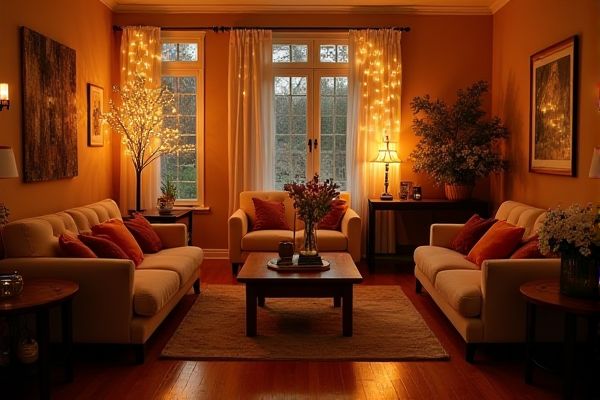
Fairy lights offer a delicate, twinkling ambiance ideal for cozy, decorative settings, while tube lights provide bright, even illumination suited for functional and large-area lighting. Discover which lighting option best enhances your space by reading the rest of the article.
Table of Comparison
| Feature | Fairy Lights | Tube Lights |
|---|---|---|
| Design | Small LED bulbs on thin wire | Long cylindrical shape, fluorescent or LED |
| Purpose | Decorative, ambiance lighting | General room illumination |
| Light Output | Soft, warm glow | Bright, uniform light |
| Energy Efficiency | Low power consumption, LED-based | Moderate to high efficiency, LED or fluorescent |
| Lifespan | 10,000+ hours (LED) | 10,000 to 20,000 hours |
| Installation | Flexible, easy to hang | Fixed ceiling or wall mounting |
| Cost | Low to moderate | Moderate |
| Common Use Cases | Decorations, festivals, parties | Office, home, commercial lighting |
| Brightness | Low to medium lumens | High lumens output |
Introduction to Fairy Lights and Tube Lights
Fairy lights consist of small LED bulbs connected by thin, flexible wires, often used for decorative ambiance in homes and events. Tube lights, also known as fluorescent or LED tube lamps, provide bright, energy-efficient illumination suitable for commercial and residential spaces. Both lighting options offer distinct advantages: fairy lights enhance aesthetic appeal, while tube lights ensure functional, widespread brightness.
Key Differences Between Fairy Lights and Tube Lights
Fairy lights consist of small, individual LED bulbs strung along a thin, flexible wire, offering delicate and decorative illumination ideal for ambiance and aesthetic appeal. Tube lights are long, rigid fixtures housing multiple LED or fluorescent tubes, designed for bright, uniform lighting in functional spaces like offices or warehouses. The primary differences lie in their structure, brightness levels, and typical usage, with fairy lights emphasizing decorative purposes and tube lights prioritizing efficiency and broad coverage.
Aesthetic Appeal: Ambiance and Design
Fairy lights offer a soft, warm glow that enhances ambiance and creates a magical, cozy atmosphere ideal for intimate settings or decorative accents. Tube lights provide uniform, bright illumination suited for functional lighting but lack the depth and charm that fairy lights bring to design. Choosing between them depends on whether the priority is aesthetic appeal and mood or practical brightness and coverage.
Energy Efficiency Comparison
Fairy lights typically consume less energy than tube lights due to their use of small, energy-saving LED bulbs that provide illumination with minimal power. Tube lights, especially older fluorescent models, tend to have higher wattage and energy consumption, though modern LED tube lights have improved efficiency considerably. Choosing fairy lights for decorative purposes can reduce your electricity usage while providing a cozy ambiance, whereas tube lights are more suited for consistent, bright lighting needs.
Installation and Flexibility
Fairy lights offer easy installation with lightweight, flexible wiring that can be shaped around furniture, ceilings, or outdoor spaces, making them ideal for creative and temporary decor setups. Tube lights, while brighter and more durable, require fixed mounting and professional installation, limiting their flexibility but providing consistent, long-term lighting solutions. Choosing fairy lights allows you to customize your ambiance effortlessly, whereas tube lights deliver robust illumination for structured environments.
Durability and Lifespan
Fairy lights typically have a shorter lifespan, lasting around 10,000 to 15,000 hours, due to their delicate design and smaller bulbs, which can be more susceptible to damage. Tube lights, often made with sturdier materials and protective casings, offer greater durability and an extended lifespan of up to 20,000 to 30,000 hours. Choosing between these lighting options depends on the need for decorative appeal versus long-term, reliable illumination.
Cost Analysis and Budget Considerations
Fairy lights generally cost less upfront than tube lights, making them ideal for budget-conscious buyers looking to create ambient lighting without a heavy investment. Tube lights offer higher energy efficiency and longer lifespans, potentially lowering your electricity bills and replacement costs over time. Careful consideration of initial expenses versus long-term savings helps you choose the best lighting option for your budget and usage needs.
Best Uses for Fairy Lights
Fairy lights are best used for creating a cozy, ambient atmosphere in bedrooms, living rooms, and outdoor patios due to their soft, warm glow and flexible design. Ideal for decorating events like weddings, parties, and holidays, they enhance visual appeal without overpowering the space. Their small size and energy-efficient LED bulbs make them perfect for accent lighting on shelves, window frames, and plants.
Best Applications for Tube Lights
Tube lights are ideal for illuminating large indoor spaces such as offices, kitchens, and garages due to their bright, even light distribution and energy efficiency. Their long, linear design allows for extensive coverage along ceilings or walls, making them perfect for task lighting and general ambient illumination. Your choice of tube lights enhances visibility and reduces energy costs, especially in commercial and industrial settings.
Which is Better: Fairy Lights or Tube Lights?
Fairy lights offer a warm, decorative ambiance ideal for cozy settings, while tube lights provide brighter, more uniform illumination suited for functional spaces. Your choice depends on whether you prioritize aesthetic appeal or efficient lighting performance. For subtle, festive decoration, fairy lights excel; for everyday tasks and energy efficiency, tube lights are better.
 homyna.com
homyna.com